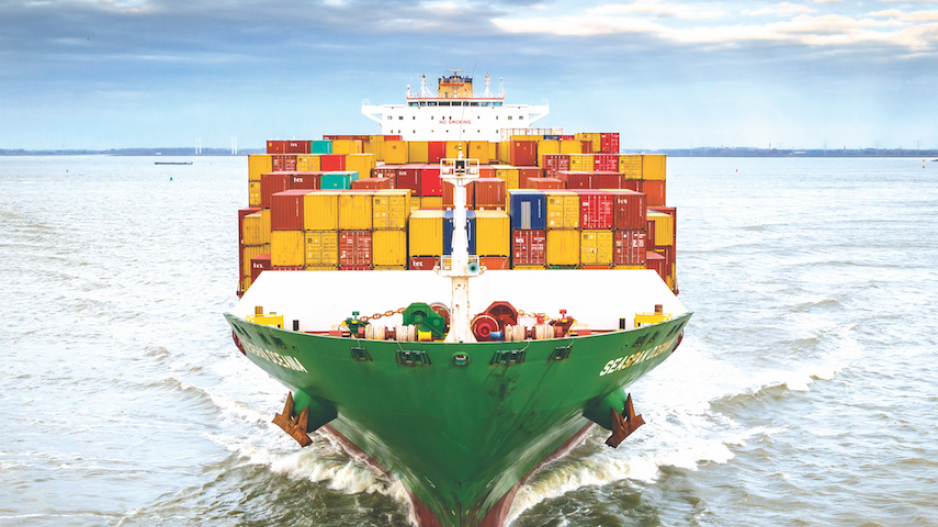Vancouver-based Seaspan Corp. (NYSE:SSW) has finalized the US$380 million purchase of six container ships in a deal that underscores the ship owner’s expansion and diversification ambitions in the volatile global marine cargo sector.
The deal, initially announced last November, comes during another year of uncertainty in a container shipping sector that continues to face challenging supply-demand fundamentals and a slowing global economy.
The acquisition increases Seaspan’s container fleet to 119 ships and its cargo capacity to about one million 20-foot-equivalent units (TEUs). Those numbers give Seaspan a 7.7% share of a global container cargo fleet that shipping data company Alphaliner estimates now has a capacity exceeding 23 million TEUs.
Finalization of the six-ship deal follows a major corporate restructuring of the world’s largest charter owner and manager of container ships in late 2019 when Seaspan’s board of directors approved the creation of Atlas Corp. to serve as Seaspan’s holding company and corporate parent.
The company also agreed to acquire APR Energy Ltd. in an all-stock transaction valued at US$750 million.
APR is the world’s largest lessor of mobile gas turbines.
Atlas and APR are part of Seaspan’s plan to diversify into the energy sector.
David Sokol, Seaspan’s chairman of the board, was named chairman of the Atlas board, and Bing Chen, Seaspan’s president and CEO, has taken on the role of Atlas director and CEO.
In a press release announcing the APR agreement, Sokol called the acquisition “a transformative transaction on our journey as professional asset managers.”
“We are bringing together two leading, integrated platforms, in two industries in which we have long-term confidence: maritime and energy,” he said.
Ryan Courson, chief financial officer for Seaspan and Atlas, added that the formation of Atlas as a global asset manager will pave the way for “diversification of capital to hard-asset-intensive industries and beyond, which we expect will yield strong through-cycle returns.”
He said Atlas will be committed to strategically allocating capital in both the maritime and energy sectors.
In Seaspan’s 2019 third-quarter conference call last November, Chen said Seaspan remained “focused on fleet growth at the right price.”
In what is an extremely turbulent shipping marketplace, opportunities for acquisition of assets at that right price increase as they become available from distressed operators.
But not all Seaspan’s recent acquisition and diversification moves have had happy endings.
In January, the company’s initial foray into alternative energy options was put on hold when Seaspan shelved plans to invest up to US$200 million in Swiber Holdings Ltd., a Singapore-based offshore oil and gas field engineering and construction business.
Seaspan’s proposed Swiber investment was announced in late 2018. What appeared to be a first step in the container shipping company’s diversification plan was contingent upon a number of conditions being fulfilled as of December 31, 2019.
Details of what those conditions were and how many were not fulfilled by the December 31 deadline have not been released, and Seaspan has declined to comment on the cancellation of the deal, but the financially troubled Swiber Holdings had been placed under judicial management in October 2016 to restructure its debt.
The proposed Swiber investment included five ships and would have given Seaspan an 80% interest in the restructured Swiber Group and a US$180 million investment in a US$1 billion liquefied natural gas-to-power project being developed in Vietnam.
Ongoing volatility in the container shipping sector is likely a key factor in Seaspan’s focus on diversification and asset acquisition.
Fourth-quarter 2019 analysis from Drewry Maritime Financial Research notes that supply and demand fundamentals will continue to work against container shipping lines in 2020. The U.K.-based shipping industry analytics firm added that global container carriers should be able to remain profitable and keep their heads above water if they keep operating costs in check, but “it will be a tightrope act, and the capacity levers of idling and void sailings will be pulled frequently.”
As previously reported in Business in Vancouver (“The Greening of Ocean Freight” – issue 1576; January 13–19), the International Maritime Organization’s low-sulphur fuel rules that came into effect on January 1 will add billions of dollars to cargo shipping operating costs. Not all of those costs can be passed on to container shipping clients and consumers.
Growth in the global economy is also projected to remain weak.
Drewry pointed to renewed tensions between the United States and Iran as another factor in rising geopolitical instability and global economic disruption.
The coronavirus outbreak in China has also rattled stock markets and chilled economic outlooks.
The World Bank, meanwhile, has projected growth in the global economy for 2020 at just 2.5%. That is only marginally above 2019’s 2.4%, which was the weakest growth rate since the 2008-09 global financial crisis. It also forecast growth among advanced economies to drop to 1.4% in 2020.
However, the World Bank pointed out, “even this tepid global rally could be disrupted by any number of threats.”
Those threats include escalating trade tensions, a resurgence in financial stress in emerging markets, heavy government debt accumulation and previously unforeseen events like the coronavirus outbreak. •
[email protected]
@timothyrenshaw




